Stores Code V2/VB 10009 Case, map, No. 4
Stores Code W10/VB 10009 Case, map, No. 4
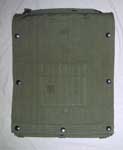


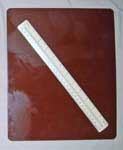 This much larger Case is only known in S.C.C. 19 green, lightweight webbing and was very much a de luxe item, which was still being manufactured in 1966, but which apparently has no introductory LoC into Section V2, the first reference being when it was transferred to Section W10 in LoC § C7422, in 1956. The main body is a gusseted pocket, open on its top, short edge and with a celluloid window. A rear flap, with wide extended edges, folds around to the front and carries three male press stud halves down each side, to which the front flap fastens. This rear flap has a half depth map pocket on its inside face. A seventh male press stud half is on a short tab, positioned centrally on the lower short edge, corresponding to an extra female stud on the flap. Inside the front flap are the usual loops for pencils and a Service Protractor. No early LoC has been noted, but LoC § C7422 introduced the Case into Section W10, in 1956. Unhelpfully, it states “Introduction”, so does not give the original LoC by which the Case was approved. Self-evidently, a 1945 Case cannot have been an introductory item in 1956, which would be tardy, even by Army standards. This example is maker marked D.R.M. Ltd., and is undated.
This much larger Case is only known in S.C.C. 19 green, lightweight webbing and was very much a de luxe item, which was still being manufactured in 1966, but which apparently has no introductory LoC into Section V2, the first reference being when it was transferred to Section W10 in LoC § C7422, in 1956. The main body is a gusseted pocket, open on its top, short edge and with a celluloid window. A rear flap, with wide extended edges, folds around to the front and carries three male press stud halves down each side, to which the front flap fastens. This rear flap has a half depth map pocket on its inside face. A seventh male press stud half is on a short tab, positioned centrally on the lower short edge, corresponding to an extra female stud on the flap. Inside the front flap are the usual loops for pencils and a Service Protractor. No early LoC has been noted, but LoC § C7422 introduced the Case into Section W10, in 1956. Unhelpfully, it states “Introduction”, so does not give the original LoC by which the Case was approved. Self-evidently, a 1945 Case cannot have been an introductory item in 1956, which would be tardy, even by Army standards. This example is maker marked D.R.M. Ltd., and is undated.
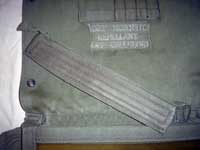
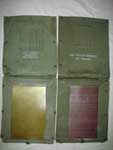
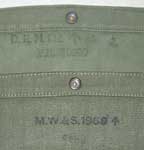 The same instruction, "KEEP MOSQUITO REPELLENT OFF CELLULOID", was stencilled in white, on the inside of the flap. The novel feature of this Case is the sealing of the top opening: a “plug” of T-section, formed in webbing, being stitched permanently at one end (far left). The upright of the T was then inserted into the opening, the flanged, or horizontal of the T forming a more weatherproof seal, when the main flap was opened. Unlike the Case No. 3, this was equipped with a permanent Sling, in ¾ -in. webbing, with a Q.R. buckle on a chape, stitched to the opposite top edge of the Case. As with Case No. 3, this was NOT a Patt. ’44 W.E. component, though plainly it was intended for jungle use. The two photos at centre and near left show two examples. One is the D.R.M.made Case shown above, whilst the second is maker marked "M.W. & S" and dated 1968. Both are from the Simon Howlett Collection, photographs © Simon Howlett 2011.
The same instruction, "KEEP MOSQUITO REPELLENT OFF CELLULOID", was stencilled in white, on the inside of the flap. The novel feature of this Case is the sealing of the top opening: a “plug” of T-section, formed in webbing, being stitched permanently at one end (far left). The upright of the T was then inserted into the opening, the flanged, or horizontal of the T forming a more weatherproof seal, when the main flap was opened. Unlike the Case No. 3, this was equipped with a permanent Sling, in ¾ -in. webbing, with a Q.R. buckle on a chape, stitched to the opposite top edge of the Case. As with Case No. 3, this was NOT a Patt. ’44 W.E. component, though plainly it was intended for jungle use. The two photos at centre and near left show two examples. One is the D.R.M.made Case shown above, whilst the second is maker marked "M.W. & S" and dated 1968. Both are from the Simon Howlett Collection, photographs © Simon Howlett 2011.
Rog Dennis 2011